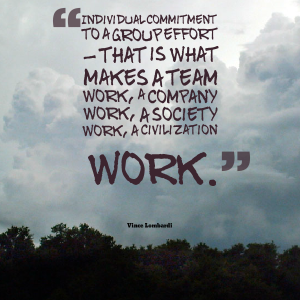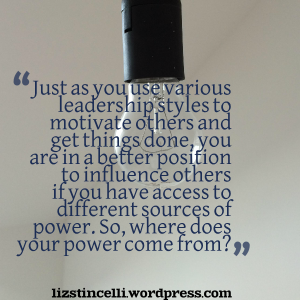Tag Archives: Leadership
Are You Earning Employee Commitment?
 “Individual commitment to a group effort – that is what makes a team work, a company work, a society work, a civilization work.” —Vince Lombardi
“Individual commitment to a group effort – that is what makes a team work, a company work, a society work, a civilization work.” —Vince Lombardi
By Elizabeth Stincelli, DM
Vince Lombardi nailed it. But, your employees don’t owe you their commitment. As a leader, it is your responsibility to earn the commitment of those in your organization. Looking out for your employees and earning their commitment is not only good for them, it’s good for you, and it’s good for business. When employees are committed to you, as a leader, and the organization, they work willingly in the best interest of the whole. It eliminates the ‘I’m only in it for me’ attitude. Employees are willing to give their ‘all’ to a leader, a cause, and a vision that they believe in. So, how can you earn employee commitment?
Relationships
The relationships you build with your employees are going to be key in earning their commitment. These relationships cannot be merely superficial; you must develop them on an individual level. This means not only being interested in them professionally, but also personally. Your relationships have to be real, no faking. Employees will see straight through your façade. Be yourself with employees; let them get to know the real, imperfect you. Show them that you are interested in their well-being and personal growth. Meaningful relationships earn commitment, boost productivity, and inspire employees to give 110%.
Trust
There will be no commitment from your employees without trust. The loyalty you need from your employees requires trust that goes both ways. No games; no tricks. Your actions and words must be honest and consistent. Show your employees that you have their backs. Create and share key learning moments with them. Be open about your failures and weaknesses. Also, you must provide them with a safe place to fail and learn from their mistakes. Give them control over their own work tasks, showing that you trust and have confidence in their abilities.
Communication
Earning commitment from your employees takes a whole lot of open and ongoing communication. Communication is a tool for sharing the organization’s stories in a way that brings employees together to be part of something important. Communication allows you to convey how employees’ work contributes to the overall success of the organization. Communication is also a two-way street. Listen more than you speak. Pay close attention to what is being shared and make sure you are on the same page. Communication helps you to remove the barriers to trust, which helps build the relationships that earn employee commitment.
Engagement
People simply work harder and are more committed when they are allowed to use their talents. When your employees are engaged in their work, they are more likely to be motivated, to remain committed to your organization, and to stay focused on achieving shared goals. Engaged employees have a sense of purpose and know they are making a difference. When you engage your employees in their work, you challenge them, bring out the best in them, and offer them the opportunity to grow and develop.
Acknowledgement
And finally, if you want to earn the commitment of your employees, acknowledge their contributions and value. Your employees are your greatest resource, don’t take them for granted. Show them that they are part of something bigger than themselves, something meaningful and important.
Earn Their Commitment
To be successful you need every employee to be committed to the group effort. They do not owe you this commitment; it is yours only when you have earned it. So, build strong relationships, develop mutual trust, cultivate open and honest communication, create an engaging workplace, and acknowledge the value and contributions of every employee. That’s how you make it work.
© 2015 Elizabeth Stincelli
Liz Stincelli is passionate about recognizing and inspiring the leader in each of us. She is the CEO of Stincelli Advisors where she focuses on helping organizations engage employees and improve organizational culture. Liz holds a Doctor of Management degree with an emphasis on organizational leadership.
Learn more about Liz by visiting her website, stincelliadvisors.com and connect with her on Twitter @infinitestin, Google+, and LinkedIn. You can contact her by email at stincelliadvisors@gmail.com.
Four Ways to Get Out of Your Own Way
 “You’ve gotta find a way to get out of your own way, so you can progress in life.” —Steve Carlton
“You’ve gotta find a way to get out of your own way, so you can progress in life.” —Steve Carlton
By Elizabeth Stincelli, DM
How much would you benefit from becoming more self-aware of the behaviors that cause you to stand in your own way? Would your focus change? Could you learn to be more curious, agile, proactive, and prepared to overcome challenges? Here are four ways to get out of your own way so you can thrive.
Let go of your ego and pride
First, you must let go of your ego. Your ego and pride will alienate those you need on your side; no one succeeds alone. They will taint your perception of reality. And, they will bias your decisions.
Challenge the status quo
The status quo is the enemy of progress. Once you have set aside your ego, you must challenge the status quo. Get comfortable with the idea of change, develop a positive attitude, and stop settling for the status quo.
Learn from your mistakes and failures
One of the keys to success is to continually learn; and, one of the best ways to learn is from your mistakes and failures. Now that you have removed the status quo barrier to progress, you need to pull together all of the lessons learned from your past mistakes. Admit vulnerability, recognize where your opportunities lie, and get comfortable with failure.
Recognize your weaknesses
Once you have thought through your past mistakes and recognize the lessons you have learned, you must recognize and admit your weaknesses. Again, no one succeeds alone; who will you need to help you accomplish your goals? Surround yourself with the right people and engage others in contributing to mutual success.
What Are You Waiting For?
So, how long are you going to stand in your own way? Let go of your ego, challenge the status quo, learn from your mistakes, and recognize your weaknesses. Get out of your own way so you can thrive.
© 2015 Elizabeth Stincelli
Liz Stincelli is passionate about recognizing and inspiring the leader in each of us. She is the CEO of Stincelli Advisors where she focuses on helping organizations engage employees and improve organizational culture. Liz holds a Doctor of Management degree with an emphasis on organizational leadership.
Learn more about Liz by visiting her website, stincelliadvisors.com and connect with her on Twitter @infinitestin, Google+, and LinkedIn. You can contact her by email at stincelliadvisors@gmail.com.
Five Ways to Hear What Your Employees are Actually Saying
 “One of the most sincere forms of respect is actually listening to what another has to say.” —Bryant H. McGill
“One of the most sincere forms of respect is actually listening to what another has to say.” —Bryant H. McGill
By Elizabeth Stincelli, DM
Why Listen?
Your employees have a huge impact on your day-to-day operations; what they have to say is important. The information that those on the front lines have to offer is extremely valuable. They are the ones with their fingers on the pulse of the organization. If you REALLY listen to what they have to say you might be able to head off problems early, learn something you don’t know, and get some great ideas. When employees know that you care about their point of view and value what they have to say, you build strong relationships and improve your organizational culture.
No ‘us vs. them’
If you want to hear what your employees actually have to say, you must eliminate any ‘us vs. them’ mentality in your organization. This mentality puts people in defensive mode. When we are on the defense, we are not even capable of higher order thinking let alone expressing ourselves in any meaningful way.
Stop talking
To actually hear what your employees are saying you must offer them multiple opportunities to communicate; a variety of settings and a variety of methods. Then, stop talking and listen. Show that you are attentive, ready and interested in what they have to say. When you aren’t focused on what you want to say, it opens the space to hear what others are saying and to notice what they’re not saying.
Ask questions
If you care about what your employees have to say, ask questions. Seems like common sense, but it doesn’t happen as often as it should. Ask what’s working and what’s not. Is there anything we should stop doing? What do we need to start doing? Ask them for input and feedback. And, don’t just ask work related questions; ask how they are doing. Let them know you care about them personally. Encourage them to ask you questions. Be honest with them. When you learn to ask the right questions you can get to the core of what your employees are actually saying.
Acknowledge what you’ve heard
One of the biggest factors in hearing what your employees are actually saying is acknowledging what you’ve heard. Verify that you understand what they are saying and demonstrate that you can see it from their perspective. Give them the opportunity to elaborate when necessary. Express appreciation for the information and feedback they provide.
Watch their energy
If you want to REALLY understand what your employees are saying, watch their energy. Their energy will send non-verbal information that helps you, as the listener, tap into what is really behind their words. Are they energetic and positive, showing passion? Are they subdued, showing lack of hope? Do they appear scattered, showing frustration or stress? The most productive conversations take place when you work together to build positive energy.
What are They Actually Saying?
Hearing what your employees are actually saying takes consistent effort. You can’t just be open to listening once in a while, it must be constant. You must eliminate even the perception of an ‘us vs. them’ mentality. You must stop talking. You need to ask the right questions. Acknowledge what you’ve heard. You must watch their energy with as much attention as you listen. You must learn to hear what is not being said as much as what is being said. In most communication there is more substance behind the words than is contained in the words. Care enough to hear what your employees are actually saying.
© 2015 Elizabeth Stincelli
Liz Stincelli is passionate about recognizing and inspiring the leader in each of us. She is the CEO of Stincelli Advisors where she focuses on helping organizations engage employees and improve organizational culture. Liz holds a Doctor of Management degree with an emphasis on organizational leadership.
Learn more about Liz by visiting her website, stincelliadvisors.com and connect with her on Twitter @infinitestin, Google+, and LinkedIn. You can contact her by email at stincelliadvisors@gmail.com.
Thriving Through Scrutiny
 “You can’t help but be scrutinized, so I might as well be doing something while I’m being scrutinized.” —Heather Locklear
“You can’t help but be scrutinized, so I might as well be doing something while I’m being scrutinized.” —Heather Locklear
By Elizabeth Stincelli, DM
You Can’t Help but be Scrutinized
As Heather Locklear points out in the above quote, you are going to be scrutinized. It happens to every single one of us every day. So, how do you thrive through the scrutiny?
Don’t react
First of all, don’t take it personally and don’t react impulsively. When you are being scrutinized it says more about the other person than it does about you. While you have no control over the thoughts and actions of others, you can control your own attitude, emotions, words, and actions. Stop your first reaction; don’t lash out and never argue; I promise it is pointless. Be mindful of your internal and external reactions. If you feel you must respond, reply with a simply say “thank you” if there is merit to the scrutiny or simply say “I disagree and there is nothing further to discuss”.
Choose your attitude
You are in control of your own attitude, choose it wisely. First, don’t play the victim. Show you are confident but not arrogant. When you feel that you are being scrutinized, it is important that you give yourself credit; what did you do right? What are you good at? While you don’t need to justify your behavior, you don’t want to become angry or defensive either. It’s good to acknowledge how the scrutiny makes you feel, but keep your attitude positive.
Don’t over think it
Consider ‘who’ is scrutinizing you. Is it someone you trust? Is it an advisor or a friend? Once you identify the role this person plays in your life, then you can seek to understand their intention. Is there any validity to it? Was it given to hurt or the help? But, don’t over think it. Listen to what is being said and what is not being said. Then, simply ask yourself “does it make sense?” If you aren’t sure how to answer that question, get a second opinion.
Is there a lesson
You can turn scrutiny into opportunity if you look for the lesson to be learned. Take responsibility for what is true; take what is helpful and discard the rest. Is there something you can learn? Is there an ongoing issue? Be open-minded and try to make it a learning moment; even if it’s only learning to control how you respond to scrutiny. Use scrutiny as an opportunity to invest time in yourself to become the best you can be.
It doesn’t define you
And, the most important way to thrive through scrutiny is by not letting it define you. Remember that no one is perfect. Don’t let the thoughts and actions of others determine the way you see yourself. You are of value regardless of what anyone else has to say.
You Might as Well be Doing Something
As Heather Locklear said in her quote, you might as well be doing something while you’re being scrutinized. So, what can you be doing? You can be exercising control over your attitude, emotions, words, and actions. You can be evaluating who is scrutinizing you and what the intentions are behind their scrutiny. You can be determining if there is a valid lesson to be learned. You can be defining yourself on your terms. And, here’s the biggest tip for thriving through scrutiny: everything outlined above should take all of 30 seconds of your time. Then, hold your head high and move on!!!
© 2015 Elizabeth Stincelli
Liz Stincelli is passionate about recognizing and inspiring the leader in each of us. She is the CEO of Stincelli Advisors where she focuses on helping organizations engage employees and improve organizational culture. Liz holds a Doctor of Management degree with an emphasis on organizational leadership.
Learn more about Liz by visiting her website, stincelliadvisors.com and connect with her on Twitter @infinitestin, Google+, and LinkedIn. You can contact her by email at stincelliadvisors@gmail.com.
Does Your Leadership Support Innovation?
 “Innovation has nothing to do with how many R&D dollars you have. When Apple came up with the Mac, IBM was spending at least 100 times more on R&D. It’s not about money. It’s about the people you have, how you’re led, and how much you get it.” —Steve Jobs
“Innovation has nothing to do with how many R&D dollars you have. When Apple came up with the Mac, IBM was spending at least 100 times more on R&D. It’s not about money. It’s about the people you have, how you’re led, and how much you get it.” —Steve Jobs
By Elizabeth Stincelli, DM
Innovation and the Leadership Pyramid
How is innovation dependent on the leadership pyramid for the support and connections necessary for success? Innovation needs the abilities and resources that those in a position of authority have to support creativity and the implementation of innovation throughout the organization. The access that leaders have to information, influence, and resources is essential to the process of innovation.
Innovation needs support and an organizational climate focused on excellence in order to be successful. For innovation to occur, team members must be able and willing to cooperate in the development and application of new ideas. The foundation needed to provide the resources and support for the collaboration that enables innovation must be provided by leadership. So, how can your leadership support innovation?
See through the informational noise
Efforts to innovate should be associated with a clear purpose, outlined objectives, and a shared vision. This clarity and direction from leaders guides innovative efforts in a direction that will provide value to organizational goals. To be successful, innovative efforts should be informed by organizational and market data and information. The vast amounts of available data can overwhelm those trying to sort through it. Leaders often have historical experience with the information which allows them to sort through the noise and identify the key information to support innovative efforts more easily.
Successful innovation requires that a diverse group of people be brought together and encouraged to share information and participate in the process of innovation. Organizational leaders have the authority to determine which individuals participate and what information is shared. Those in a leadership position often have the big picture understanding that is useful in determining who should participate and what information will be beneficial to innovative efforts.
Leaders must manage the knowledge resources of the organization. To successfully innovate, one needs access to accurate information, the capability to connect the informational dots, and the ability to filter pertinent from arbitrary information. Leaders have access to the data and resources necessary to help innovators see through the informational noise
The ability to execute
The end goal of innovation is execution. It is the responsibility of the leader to decide which projects are right for implementation. Successful innovation can only take place when leaders design organizational processes that support innovation and the implementation of new ideas. Leaders also have the ability to support learning from failed attempts to implement innovative ideas rather than instilling a fear of failure.
For innovative ideas to be successful, leaders must provide the practical support for implementation. They must supply the necessary resources to test new ideas. Leaders must manage the people, time, knowledge, and resources allocated to innovative efforts and implementation. Leaders have the authority and resources necessary to execute on innovative ideas.
Build a culture that supports innovation
A culture that supports innovation provides a safe place to experiment, to fail, and to learn. It must emphasize collaboration and the continual pursuit of excellence. The leader must provide the support and climate that encourages creativity and curiosity that facilitates innovation. The responsibility for developing a high-performance, innovative culture falls on organizational leaders.
A culture that supports knowledge sharing and collaborative work practices increases innovation. This type of culture eliminates silos and supports ongoing, open communication. It gives people the opportunity to collaborate by providing permission, time, and resources. An innovative culture rewards the sharing of ideas and knowledge. Successful innovation is encouraged when learning becomes entrenched in the culture.
People must feel safe to make mistakes and then talk about them openly so others can learn from them. An organization that supports successful innovation has a culture where shared decision-making, experimenting, learning, and development are emphasized. Developing a culture that supports learning and diversity has an innovative competitive advantage. This type of culture allows innovation to grow from shared experiences and differing conceptual lenses. Leaders have the influence necessary to build a culture that supports innovation.
Collaboration not competition
Organizational leadership should support innovative collaboration over a mindset of competition. Collaboration requires the sharing and exploration of knowledge across departments, roles, and regions. The contribution of diverse expertise enhances organizational learning, the creation of knowledge, and complex problem-solving. Competition can stifle the ability to share and build on the knowledge and experiences of others. While competition may offer the short-term satisfaction of a personal victory, the satisfaction gleaned from collaborative success can be long-lasting.
Organizational policies should not be overly restrictive in the access that is allowed to pertinent data. Policies should not foster a culture that encourages secrecy and internal competition. Collaboration should challenge ideas in a positive, co-creative way. An important factor in innovation is the support of leadership in encouraging team diversity and the sharing of information to enhance creativity and problem-solving through collaborative efforts rather than competition. Leaders have the influence to set the climate of innovation as collaborative rather than competitive.
Conclusion
Successful innovation is dependent on the data, resources, authority, and influence that leaders can provide. Individuals in a position of authority have the ability to see through the informational noise, execute on ideas, build a supportive culture, and encourage collaboration rather than competition. Become the leader who provides the direction, support, influence, and resources necessary for successful innovation in your organization.
© 2015 Elizabeth Stincelli
Liz Stincelli is passionate about recognizing and inspiring the leader in each of us. She is the CEO of Stincelli Advisors where she focuses on helping organizations engage employees and improve organizational culture. Liz holds a Doctor of Management degree with an emphasis on organizational leadership.
Learn more about Liz by visiting her website, stincelliadvisors.com and connect with her on Twitter @infinitestin, Google+, and LinkedIn. You can contact her by email at stincelliadvisors@gmail.com.
Why Do Your Employees Hate You?
“A good leader can engage in a debate frankly and thoroughly, knowing that at the end he and the other side must be closer, and thus emerge stronger. You don’t have that idea when you are arrogant, superficial, and uninformed.” —Nelson Mandela
By Elizabeth Stincelli, DM
I am surprised when managers act shocked to find out that their employees don’t like them. You have to remember that the way you think affects your behavior and your behavior determines how your employees react to you. If you don’t pay close attention to your thoughts this can become a vicious cycle. So, why do your employees hate you?
You think your title makes you a leader
I can tell you that one of the biggest factors that causes employees to hate you as their manager is if you think that your title makes you a leader. You don’t become a leader just because you get placed in a management position. Leadership is something that you grow into and earn. Chances are that if you think your title makes you a leader, you also think it entitles you to power. You may have control over rewards or consequences that give you the power to accomplish short-term tasks. This, however, does not equate to long-term power that is earned through respect.
They don’t trust you
If you don’t trust your employees, they won’t trust you. People like people they trust. Animosity is created when your employees’ notice that you think you know more than them, you stop listening to what they have to say, and you are always keeping score. When it appears that you do not trust them, they stop engaging with you even when you ask them questions. They don’t feel like they can be themselves around you. You can’t command trust and respect, you have to give it first and then earn it.
You fail to build relationships
Even if you had strong relationships at some point, when you were promoted you may have become distant and bureaucratic. Your relationships may have become superficial and fake; employees can see right through your facade. After making the move into a management position, it is easy to forget what it’s like to be the low man on the totem pole or working on the front lines. You fail to build relationships on an individual basis where each employee knows that you care about them personally. If you start relying on email as your main form of communication you lose that face-to-face interaction that can be so important to relationship building. You don’t encourage, welcome, ask for, or act on feedback which reinforces the perception that you don’t care what your employees have to say.
You have something to prove
You think that leadership requires you to make sure everyone knows you’re in charge. In fact, it is quite the opposite. If you need to prove that you are in charge, you’re not a leader. You feel you have something to prove, all the time. You’re smarter, stronger, braver, or more powerful; it’s always something. You default to the use of fear and intimidation when you feel you’re not getting the respect you think you deserve. And, you never admit when you are wrong. No one likes a know-it-all. If you are always trying to one-up your employees, chances are they will start to hate you.
You don’t value their contributions
When you think you’re all that, you tend to minimize the contributions of others. When you don’t recognize the value of your employees’ contributions or reward them for a job well done their distaste for you grows. If you don’t recognize their value you will fail to challenge them or engage their creativity. Everyone wants to feel that their contributions are valued and that their efforts are worthwhile.
Turn it Around
So, now you know some of the main reasons your employees might hate you, what can you do to turn it around? Start by recognizing that you become a manager by being promoted or hired into that position, but you become a leader by focusing on the needs of others rather than gaining power for yourself. Show your employees that you trust them and their abilities, communicate openly, and stop keeping score. Remember that you are not a leader if you need to prove that you are in charge. And finally, recognize that every employee adds value. Leadership is influence, and you can’t influence those who hate you. Pay close attention to your thoughts for they will become your behavior. Turn it around.
© 2015 Elizabeth Stincelli
Liz Stincelli is passionate about recognizing and inspiring the leader in each of us. She is the CEO of Stincelli Advisors where she focuses on helping organizations engage employees and improve organizational culture. Liz holds a Doctor of Management degree with an emphasis on organizational leadership.
Learn more about Liz by visiting her website, stincelliadvisors.com and connect with her on Twitter @infinitestin, Google+, and LinkedIn. You can contact her by email at stincelliadvisors@gmail.com.
So, where does YOUR power come from?
Where Does Your Power Come From?
 “Power is like being a lady… if you have to tell people you are, you aren’t.” —Margaret Thatcher
“Power is like being a lady… if you have to tell people you are, you aren’t.” —Margaret Thatcher
By Elizabeth Stincelli, DM
Sources of Power
Power is the ability to influence the behavior of others, to overcome resistance, and to get people to do things they may not otherwise do. There are two main bases of power: positional power and personal power. You can access these bases through several sources. You can possess positional power as either legitimate, reward, or coercive. Your personal power can be either expert or referent. Each of these forms of power can achieve differing degrees of effectiveness based on the specific situation you are facing.
Just as you use various leadership styles to motivate others and get things done, you are in a better position to influence others if you have access to different sources of power. So, where does your power come from?
Positional power
Positional power is based on your rank within the structure of your organization and is granted to you by someone who is your superior. This form of power is task oriented and focused on giving orders without asking subordinates for their input or ideas. Much of its effectiveness is dependent on your ability to either reward or punish those who work under you. Use of positional power often results in low work satisfaction, lack of commitment, high job stress, high turnover, and even sabotage.
Legitimate power
Legitimate power is a form of positional power that can also be referred to as formal authority. This source of power relies solely on holding a position of responsibility. With legitimate power, you have the right to command others based on your position within the structural hierarchy of the organization.
Reward power
Reward power is a form of positional power that is based on your ability to control tangible benefits such as parking spaces, flexible work schedules, promotions, or bonuses. Reward power operates on the desires of others. When you have the authority to determine who will receive rewards or eliminate unpleasant penalties, you have reward power.
Coercive power
Coercive power is a form of positional power that is based on your ability to punish, discipline, or withhold rewards when subordinates do not act in accordance with commands or requirements. Coercive power operates on other’s fears. When you have the authority to determine and deliver punishment or withhold desired rewards, you have coercive power.
Personal power
Personal power is based on individual qualities. It is not necessarily given by superiors, but instead, by subordinates themselves. This form of power is relationship oriented. Personal power is held by individuals who behave in ways that motivate and inspire others. They create a supportive organizational environment where they recognize and acknowledge the individual needs of others. They are active listeners who encourage two-way communication and focus their energy on helping others grow. Use of personal power usually results in higher motivation and productivity, lower stress levels, and stronger commitment.
Expert power
Expert power is a form of personal power that stems from the unique expertise, specific knowledge, or skill set of an individual. If you possess expert power, you influence others because you have specific qualities and proficiencies that they value. You are the go-to person for advice. You are an expert as solving problems or performing tasks.
Referent power
Referent power is a form of personal power that stems from an individual’s charisma and reputation. It is derived from personal characteristics that result in admiration from others. If you possess referent power, you have the ability to influence others based on your charisma and reputation. People like you and admire your accomplishments. They believe in your causes and see you as a role-model. People trust you and follow you willingly.
Where Does Your Power Come From?
Leadership is influence and power is the tool that gives you the ability to influence the behavior of others. Both positional and personal power can be effective in specific situations. The task oriented nature of positional power is effective at accomplishing short-term, production oriented goals but can have a negative effect on job satisfaction and motivation in the long run. Being relationship oriented, personal power builds a strong culture and increases productivity.
It is important to evaluate and understand your sources of power. Which one will work best based on your current situation and goals? Which one will serve you best in the long-run? By answering these questions, you will become more effective at influencing others.
So, where does YOUR power come from?
© 2015 Elizabeth Stincelli
Liz Stincelli is passionate about recognizing and inspiring the leader in each of us. She is the CEO of Stincelli Advisors where she focuses on helping organizations engage employees and improve organizational culture. Liz holds a Doctor of Management degree with an emphasis on organizational leadership.
Learn more about Liz by visiting her website, stincelliadvisors.com and connect with her on Twitter @infinitestin, Google+, and LinkedIn. You can contact her by email at stincelliadvisors@gmail.com.
Why Do I Feel So Overwhelmed?
 “Time management is an oxymoron. Time is beyond our control, and the clock keeps ticking regardless of how we lead our lives. Priority management is the answer to maximizing the time we have.” —John C. Maxwell
“Time management is an oxymoron. Time is beyond our control, and the clock keeps ticking regardless of how we lead our lives. Priority management is the answer to maximizing the time we have.” —John C. Maxwell
By Elizabeth Stincelli, DM
The Hamster Wheel
I hear over and over again comments along the lines of, “Day in and day out, the hamster wheel turns, and I have gotten nowhere.” I feel this way myself at times and I sit and wonder why I feel so overwhelmed. I sympathize with the frustration, the feeling that there is never enough time in the day.
So many factors play into us becoming overwhelmed: the distractions, the interruptions, the meetings, and constantly changing priorities. And, it never seems to get easier; the more valuable you become, the more the demands that are made on your time.
So, if you want to get off the hamster wheel: first, come to terms and get comfortable with the fact that it is not possible to complete your entire to-do list every day; second, develop these healthy habits that will help you manage your priories.
Start out on the right foot
Develop the habit of getting into the office early to get the day started out on the right foot. Try to get into the office at least one hour before anyone else. This hour is often the only peace you will have all day and you might get more done in that short period than the whole rest of the day. Getting in early can be more productive than working late because after the day has turned to chaos, you end up exhausted with your mind going 100 different directions. First thing in the morning things are calm and you can think straight.
Must-dos
The next habit is identifying the must-dos on your to-do list. Now, everyone says that everything on their to-do list is a must-do. But, what are the absolute must-dos for tomorrow? Keep a running to-do list so that nothing slips through the cracks, but each night, before you leave the office, identify the three must-dos for the next day. A list any longer than three will overwhelm you and will be unrealistic to complete. With a list longer than three, you end your day feeling like you have failed. Get real about your must-dos, get in early, and get them tackled.
Set boundaries
The habit of setting boundaries is imperative if you want to stop feeling so overwhelmed. Get in the habit if setting aside time in 90-minute blocks to focus on your must-dos. Sometimes it is difficult to focus, undisturbed for 90-minutes; but if you learn to really set some boundaries and stick to them you can do it and it will make a world of difference. Whether it’s a closed door or a do not disturb sign, get people to understand that you are unavailable during this 90-minutes every day and that you will get with them as soon as you can.
Meetings are another opportunity to set boundaries. They are our biggest time wasters. While the demand of meetings on your time might not be 100% in your control, do whatever you can to minimize the number of meetings you must attend and help them to run as efficiently as possible. You have to teach people that you will not drop everything for a last minute meeting unless it is a significant matter.
Batch tasks
In our always connected world, distractions and interruptions are priority management killers. We waste so much time bouncing back and forth between emails, voicemails, social media, and the task at hand. Develop the habit of batching tasks such as checking voicemail and emails so that you sit down for 20 minutes and go through them and then don’t check again until you can sit for another 20 minutes. Getting distracted by email or phone calls for a minute here and a minute there eats away at your day quickly.
Delegate
As we take on more and more responsibilities, it becomes important to develop the habit of delegation. Look at your team; find a bright, energetic, ambitious team member who you can engage, mentor, and delegate tasks too. This not only helps clear your plate, it’s a great opportunity for your team members to be challenged and gain experience that will benefit them in the future. Just make sure you don’t delegate so much to one person that they become overwhelmed themselves.
Communicate
And then there is the habit of communication. First, you must get a clear understanding of what your priorities should be from your manager’s point-of-view. You must also clearly communicate the priorities to your team members. You must communicate regularly with your manager, keeping them in the loop. Let them know what you are working on and which team members are working on which projects. Communication becomes even more important if you feel that it is not possible to meet all of the demands that are being placed on you.
Conquer the Overwhelm
And last, but most important, take care of yourself!!!!! You cannot give 100% if you are working 13-14 hours, seven days a week. You have to draw the line somewhere. You will be much more effective in the time you are working if you have time to rest, recover, and restore. Take a few deep breaths, develop some healthy priority management habits, set some boundaries, make time to take care of yourself, and conquer the overwhelm.
© 2015 Elizabeth Stincelli
Liz Stincelli is passionate about recognizing and inspiring the leader in each of us. She is the CEO of Stincelli Advisors where she focuses on helping organizations engage employees and improve organizational culture. Liz holds a Doctor of Management degree with an emphasis on organizational leadership.
Learn more about Liz by visiting her website, stincelliadvisors.com and connect with her on Twitter @infinitestin, Google+, and LinkedIn. You can contact her by email at stincelliadvisors@gmail.com.



